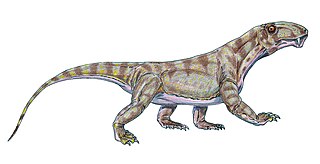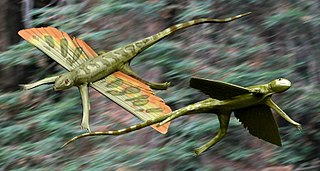 W
WBiarmosuchidae is a family of biarmosuchian therapsids from Russia.
 W
WBuffalopterus is a prehistoric eurypterid from the Silurian-aged Bertie Formation of New York and Ontario. The genus contains one species, B. pustulosus. It is closely related to Strobilopterus, but differs primarily by having a bizarre, globular telson, and in size, being estimated to be at least 1 meter in length.
 W
WCantius is a genus of adapiform primate that lived in North America and Europe during the early Eocene.
 W
WDelorhynchus is an extinct genus of lanthanosuchoid parareptile known from the late Early Permian Garber Formation of Comanche County, Oklahoma, south-central United States. It contains the type species D. priscus as well as a better preserved second species D. cifellii.
 W
WHeterodontosaurus is a genus of heterodontosaurid dinosaur that lived during the Early Jurassic, 200–190 million years ago. Its only known member species, Heterodontosaurus tucki, was named in 1962 based on a skull discovered in South Africa. The genus name means "different toothed lizard", in reference to its unusual, heterodont dentition; the specific name honours G. C. Tuck, who supported the discoverers. Further specimens have since been found, including an almost complete skeleton in 1966.
 W
WIschigualastia is an extinct genus of dicynodonts, that lived during the Carnian age of the Late Triassic Period. The genus was found in and named after the Ischigualasto Formation of the Ischigualasto-Villa Unión Basin in northwestern Argentina. It has been placed in the family Stahleckeriidae.
 W
WKenyapithecus wickeri is a fossil ape discovered by Louis Leakey in 1961 at a site called Fort Ternan in Kenya. The upper jaw and teeth were dated to 14 million years ago. One theory states that Kenyapithecus may be the common ancestor of all the great apes. More recent investigations suggest Kenyapithecus is more primitive than that and is only slightly more modern than when Proconsul is considered to be an ape.
 W
WKuehneosaurus is an extinct genus of Late Triassic kuehneosaurid reptile known from the Late Triassic of Luxembourg. It was named by P. L. Robinson in 1962 and the type and only species is Kuehneosaurus latus. Measuring 72 centimetres long, it had "wings" formed from ribs which jutted out from its body by as much as 14.3 cm, connected by a membrane which allowed it to slow its descent when jumping from trees. It is a member of a family of gliding reptiles, the Kuehneosauridae, within the larger group Lepidosauromorpha, which also contains modern lizards and tuatara.
 W
WLeptictidium is an extinct genus of small mammals that were likely bipedal. Comprising eight species, they resembled today's elephant shrews. They are especially interesting for their combination of characteristics typical of primitive eutherians with highly specialized adaptations, such as powerful hind legs and a long tail which aided in locomotion. They were omnivorous, their diet a combination of insects, lizards and small mammals. One of the first branches to split from basal eutherians, they appeared in the Lower Eocene, a time of warm temperatures and high humidity, roughly fifty million years ago. Although they were widespread throughout Europe, they became extinct around thirty-five million years ago with no descendants, probably because they were adapted to live in forest ecosystems and were unable to adapt to the open plains of the Oligocene.
 W
WRhineceps is an extinct genus of temnospondyl amphibian in the family Rhinesuchidae. Rhineceps was found in Northern Malawi in Southern Africa known only from its type species R. nyasaensis. Rhineceps was a late Permian semi-aquatic carnivore that lived in streams, rivers, lakes or lagoons. Rhineceps is an early divergent Stereopondyl within the family Rhinesuchidae, which only existed in the late Permian (Lopingian) and failed to survive the Permian-Triassic extinction unlike other stereospondyl families.
 W
WSinohippus is an extinct equid genus belonging to the subfamily Anchitheriinae.